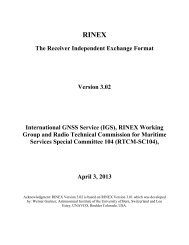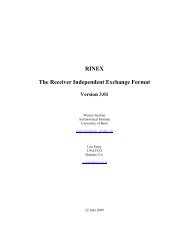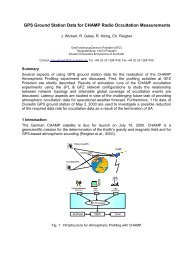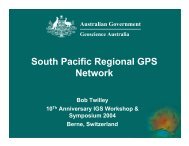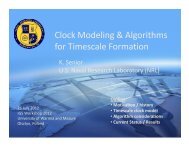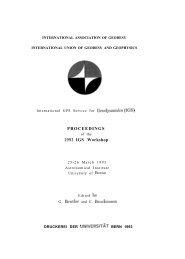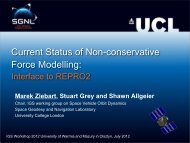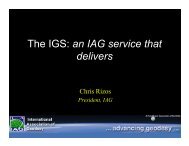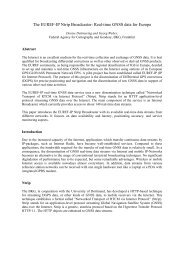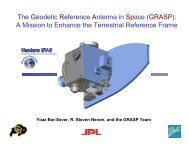to <strong>IGS</strong> in the sp3 orbit files.In Figure 5.1 the station clock solutions for the two most precise Hydrogen Masers (HM) in the<strong>IGS</strong> network are compared, HM clocks have the highest precision and stability over periods ofseveral hours. After removing an offset and drift they in effect provide a convenient ground truthat a cm (.03ns) level. The HM clock at ALGO served as a time reference and the FAIR HM clockwas treated as unknown with a large, 1 second apriori sigma. As seen from the above figure theagreement between the two HM’s is at the 0.1 ns (3cm) level which is also consistent with formalclock sigmas. The systematic variation of about 0.2ns seen is likely due to orbit errors and changesin observed satellite constellation rather than the instability of the HM clocks. Satellite clocksolutions have formal errors comparable with the station clock solutions i.e. a few cm; but, theaccuracy and consistency tests are not possible here since there is no HM satellite yet! The situationchanges dramatically when clock estimation is based bn undifferenced phase data only (the currentsituation for AS satellites, since the problem with AS pseudorange observations has not beencorrected at most <strong>IGS</strong> stations), then formal sigmas increase to about 10ns (or 3m.).For convenience and completeness clock solutions should be also combined and included in the<strong>IGS</strong> official orbit product. Problems with the combination of different satellite clock solutions aresimilar to the problems encountered with orbit combinations, i.e. first reconciling the referencetime frame differences, then detection, rejection of outliers and weighting of the individual clocksolutions. A clock combination can be based on the orbit combination approach of Section 2.Reference time frame problems are rather specific and depend on approaches to time referencedefinition within a particular solution, There are many possible approaches which can be used,ranging from a single station (fixed) reference to weighting some apriori clocks either for somestations or satellites or both. The ideal and most desirable case would be to introduce or connectsome <strong>IGS</strong> stations to BIPM primary standards. This would not only enhance the lGS clockreference but also enhance BIPM’s time transfer and maintenance. Currently it is not possible tocombine the satellite clock information since only one <strong>Center</strong> contributes satellite clock solutions,however for the permanent service the contributing <strong>Center</strong>s should be encouraged to develop andsubmit satellite clock estimations.6. CONCLUSIONS AND RECOMMENDATIONSTwo methods for orbit combinations were presented and tested here, the first is based on aweighted average and the second is a rigorous orbit determination with orbits introduced aspseudo-observations. Both methods gave nearly equivalent combined orbits, agreeing at 5cm(RMS) in position and below O. lmas in orientation. The baseline tests in North America and inEurope also indicated that both combined orbits are practically equivalent and comparable to orbetter than the best (regional) orbits. Both types of orbits implied precision and orientation stabilityat or below the 3 ppb and 0.5mas, respectively. Satellite clock solutions and combination at the0.1 ns consistency level are also possible. Problems which require additional studies and attentioninclude: the choice of reference pole (IERS or a GPS solution), sub-daily EOP representation,mitigation or elimination of orbit discontinuities, reporting orbit accuracy, processingstandardization etc.The following recommendations are offered:1. The <strong>IGS</strong> combined orbits are based on both methods described and tested above, more55
specifically the preanalysis can be based on the orbit dynamics method with longer arcs(Section3) and the combined orbits, at least in the beginning, are based on the weighting orbitmethod of Section 2.2. Strict deadlines for orbit submission and the <strong>IGS</strong> orbit release are established and adhered toby all <strong>Center</strong>s and <strong>IGS</strong> (e.g. two weeks). After the deadline, late orbits will not be includedinto the combined <strong>IGS</strong> orbit.3. Individual <strong>Center</strong> orbits will continue to be available from <strong>IGS</strong>.4. The current orbit comparison will be enhanced and based on the adopted <strong>IGS</strong> orbitcombination process.5. Satellite clock solutions are combined by means of weighted averages and should be includedin the <strong>IGS</strong> orbit product. The time reference for the clock solutions is consistent and basedon the international time standards, i.e. a close cooperation between <strong>IGS</strong> and BIPM isestablished.7. REFERENCESBeutler G., The 1992 <strong>IGS</strong> Test Campaign, Epoch’92, and the <strong>IGS</strong> PILOT Service: An Overview.Proceedings of the 1993 <strong>IGS</strong> <strong>Workshop</strong>, held March 24-26, Bern, Switzerland, pp. 3-9,1993.Beutler, G., E. Brockmann, W. Gurtner, U. Hugentobler, L. Mervart, Rothacher, A. Verdun,Extended Orbit Modelling Techniques at the CODE Processing <strong>Center</strong> of the internationalGPS Service for Geodynamics (lGS): Theory and initial results, a paper submitted toManuscript Geodetica, July, 1993 (in prep.)Goad, C. C., <strong>IGS</strong> Orbit Comparisons, Proceedings of the 1993 <strong>IGS</strong> <strong>Workshop</strong>, held March 24-26,Bern, Switzerland, pp. 218-225, 1993.Press, W. H., B.P. Flannery, S.A. Teuholsky, W.T. Vetterling, Numerical Recipes, CambridgeUniversity Press (pp. 544-545), 1989.Springer T.A., G. Beutler, Towards an official <strong>IGS</strong> orbit by combining the results of all <strong>IGS</strong>Processing <strong>Center</strong>s. Proceedings of the 1993 <strong>IGS</strong> <strong>Workshop</strong>, held March 24- 26, Bern,Switzerland, pp. 242-250, 1993.56
- Page 1 and 2:
●INTERNATIONAL ASSOCIATION OF GEO
- Page 3 and 4:
TABLE OF CONTENTS.FINAL AGENDA . .
- Page 5 and 6:
13:30 NGS14:00 S1014:30 EMR15:00 CO
- Page 7 and 8: LIST OF PARTICIPANTS:Prof. Gerhard
- Page 10 and 11: Table 1. Current IGS Analysis Cente
- Page 12 and 13: The first field identifies the reco
- Page 14 and 15: Summary InformationThe third produc
- Page 16 and 17: From Figure 1 we find that there ar
- Page 18: to define a reference clock in thei
- Page 22 and 23: SESSION 2(IGS orbit products)
- Page 24 and 25: 1. introductionThe main objectives
- Page 26 and 27: ecause of the above averaging. This
- Page 28 and 29: RMS per center (m)o 0 0 0 0 0 oA0Iv
- Page 30: Scale (ppb)I I I I I 11+-b~ul0Amo&I
- Page 33 and 34: and NGS. Note that the day to day v
- Page 35 and 36: Rotation around X-axis (mas)1&0 0o
- Page 37 and 38: discussed in Section 3 are here see
- Page 39 and 40: -----------------------------------
- Page 41 and 42: Residuals in Meters1 1 1 1 1 1 1=%m
- Page 43 and 44: Residuals inMeters11111cnficJJw-o A
- Page 45 and 46: I I I—Residuals in Meters..—.
- Page 47 and 48: 1111ResidualsMeters,—{44
- Page 49 and 50: Residuals in MetersI I I II I I IIc
- Page 51 and 52: Rms in MetersI 1 ! I 1 10 n0 a0n.ff
- Page 53 and 54: IGS- and the COM-sets, but that the
- Page 55 and 56: Table 4.1 N.A. Baseline Repeatabili
- Page 57: ..Figure 5.1:Clock solutions for FA
- Page 61 and 62: discussion, a question as to whethe
- Page 63 and 64: SUMMARY OF SESSION 3This Session be
- Page 65 and 66: IGS POSITION PAPER, IGS ANALYSIS CE
- Page 67 and 68: and Earth orientation parameters (E
- Page 69 and 70: LbPIERS and IGSCentral Bureausand D
- Page 71 and 72: @ IGS will develop instructions, an
- Page 73: 2.2 Analysis Center System DesignFi
- Page 76 and 77: applied to the solution in order to
- Page 78 and 79: ..standard deviations. This is conv
- Page 80 and 81: known, the two solutions will be ad
- Page 82 and 83: errors, and can therefore be used a
- Page 84 and 85: International Terrestrial Reference
- Page 86 and 87: Thus, there is the potential of fee
- Page 88 and 89: 90” 100” 110” 120” 130” 1
- Page 91 and 92: adiation parameters for each satell
- Page 93 and 94: Bock, Y., R.I. Abbot, C.C. Counselm
- Page 95 and 96: SUMMARY OF SESSION 4This session st
- Page 97 and 98: INTERNATIONAL EARTH ROTATION SERVIC
- Page 99 and 100: x- differences with IERS0.001”I I
- Page 101 and 102: SUMMARY OF SESSION 5In the last ses
- Page 103 and 104: 1) I(X3 PROCESSING/REPORTS/FORMATSS
- Page 105 and 106: IGS should foster and encourage reg
- Page 107 and 108: ..INTERNATIONAL GPS SERVICE FORGEOD
- Page 109 and 110:
ortL.s.4
- Page 111 and 112:
1234567a91011121314IsIt17ItIs2C2122
- Page 113 and 114:
. Ruth Neilan16S Central BureauJet
- Page 115 and 116:
ON1T.>● Jim ZumbergeJet Propulsio
- Page 117:
PROPOSED ORGANIZATION OF THE INTERN




